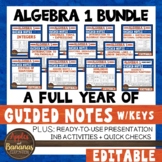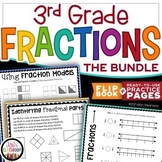24 results
Calculus unit plans for staff
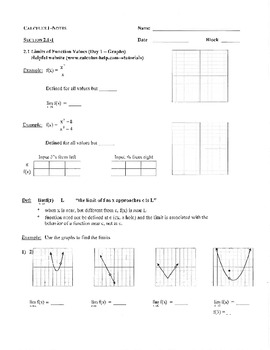
Calculus Chapter 2 Limits
This is a unit in Calculus on Limits, Trig Limits, Continuity and Drawing Graphs.
Includes notes for each section, worksheets and a practice test with answer key.
Subjects:
Grades:
10th - 12th, Higher Education, Adult Education, Staff
Types:
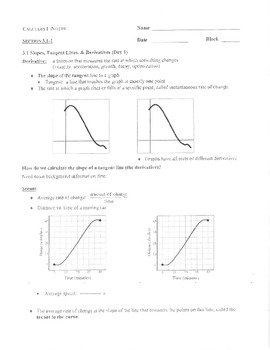
Calculus Chapter 3 Derivatives
This is a complete unit on Slopes, Tangent Lines, Derivatives, Product Rule, Quotient Rule, Chain Rule and Implicit Differentiation.
The unit includes student note sheets for each section, worksheets and practice tests.
Subjects:
Grades:
10th - 12th, Higher Education, Adult Education, Staff
Types:

RULES of LOGARITHMS & SOLVING LOGARITHMIC EQUATIONS
Logarithms helps us represent large numbers in very compact form. It can also be used to tell us how many of one number we must multiply to get another number.
The exponential function y=a^x is one of the most important functions in mathematics, physics, and engineering. Applications relating to radioactive decay, bacterial growth, population growth, continuous interest all involve exponential functions. We know that logarithmic and exponential functions are inverses. This means one can chan
Subjects:
Grades:
9th - 12th, Higher Education, Adult Education, Staff
Types:
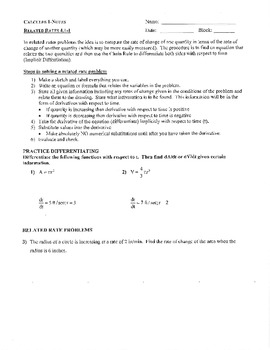
Calculus Chapter 4 Antiderivatives
My chapter 4 unit covers the following topics: Related Rates,Extreme Values of Functions, First and Second Derivative Test, Graphs, Optimization, Antiderivatives
This is a complete unit including note sheets, worksheets and practice tests with answers.
Subjects:
Grades:
10th - 12th, Higher Education, Adult Education, Staff
Types:

AP CALCULUS AB - Summation(sigma) notation and Riemann Sums
Summation or sigma notation is a way to express a long sum into a single compact expression.FINDING THE AREA UNDER THE CURVE OF A FUNCTION BY USING RECTANGLES Given a continuous function that is defined over an interval [a,b], we can approximate or find the exact the area under the curve of f(x) by using Riemann sums. This can be done by evaluating a lower or upper Sum of areas of (rectangles that lie above or below the graph) of f(x).Finally, find the exact area by evaluating: STEPS: The proces
Subjects:
Grades:
8th - 12th, Higher Education, Adult Education, Staff
Types:
Also included in: BASIC CALCULUS
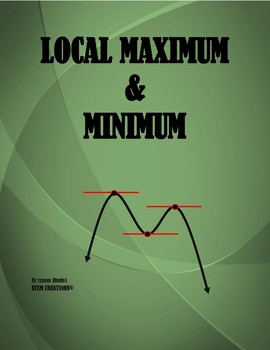
CALCULUS: LOCAL MAXIMUM AND LOCAL MINIMUM
Objectives:
Upon completion of this section, the student should be able to:
• Use derivatives to determine the intervals of increase and decrease of a given function
• Use the First Derivative Test to determine any local maximum or minimum points
Subjects:
Grades:
11th - 12th, Higher Education, Adult Education, Staff
Types:
Also included in: BASIC CALCULUS
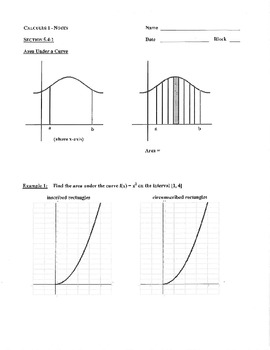
Calculus Chapter 5 Area Under Curves
This is a Calculus unit on Area Under Curves, Integration, Substitution in Definite Integrals and Indefinite Integrals.
Includes notes for each section, practice worksheets and a practice test with answer key.
Subjects:
Grades:
10th - 12th, Higher Education, Adult Education, Staff
Types:

AP CALCULUS AB - FINDING LIMITS & FUNCTION CONTINUITY (BUNDLED LESSONS)
This lesson on using Riemann sums to find the area under the graph of a function is intended for students enrolled in AP Calculus AB or BC, Calculus Honors, or College Calculus.In this document, we explore the following:1. How to find the limit of a function graphically with examples.2. How to find the limit of a function numerically with examples.3. How to find the limit of a function algebraically with examples.4. How to determine whether a function is continuous at a point and over an interva
Grades:
10th - 12th, Higher Education, Adult Education, Staff
Types:
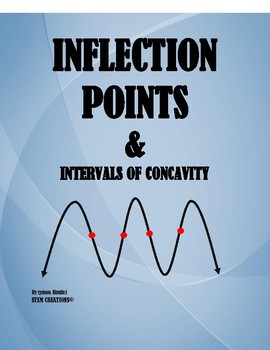
CALCULUS: INFLECTION POINTS AND INTERVALS OF CONCAVITY
Objectives:
Upon completion of this section, the student should be able to:
• Find inflection points
• Use the concavity test to determine the intervals of concavity of a function
Subjects:
Grades:
10th - 12th, Higher Education, Adult Education, Staff
Types:
Also included in: BASIC CALCULUS
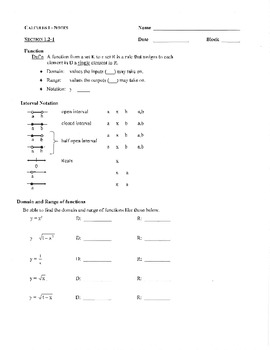
Calculus Chapter 1
This is a unit for chapter 1 in Calculus. It includes note sheets, handouts and a practice test with answers. The following topics are covered:
Domain & Range
Piecewise Functions
Operations of Functions
Absolute Value
Translations and Parabolas
Trig Functions
Subjects:
Grades:
9th - 12th, Higher Education, Adult Education, Staff
Types:
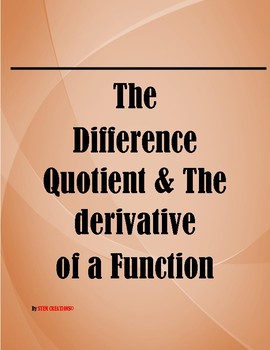
AP CALCULUS AB - The difference quotient formula and the derivative
In this e-document we describe the process of finding the difference quotient formula of a function. Next we show how we can use the difference quotient to find the derivative ( rate of change function) of a function.Some examples on how to use the derivative to find the slope of tangent line at a specific point on the graph of a function is give.
Subjects:
Grades:
10th - 12th, Higher Education, Adult Education, Staff
Types:
Also included in: BASIC CALCULUS
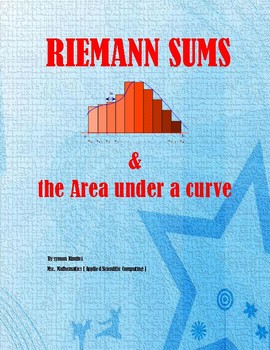
AP CALCULUS AB - SIGMA NOTATION AND RIEMANN SUMS - A general introduction
This lesson on using Riemann sums to find the area under the graph of a function is intended for students enrolled in AP Calculus AB or BC, Calculus Honors, or College Calculus.The procedure outlined in this e-book is a step by step example on how one can approximate the net area between the x-axis and the curve y=f(x) for a ≤ x ≤ b using Riemann Sums. Given any continuous function f(x), and the values a, b and n, the number of subintervals, it is possible to approximate the area under the curve
Subjects:
Grades:
10th - 12th, Higher Education, Adult Education, Staff
Types:
Also included in: BASIC CALCULUS

PHYSICS: OBJECTS IN PROJECTILE MOTION
This document describes in detail the basic concept of projectile motion.
When an object is thrown above the ground with an initial velocity u at an angle to the ground, it experiences projectile motion. In a vacuum, the only force acting on the object would be the downward gravitational force. The projectile motion is such that the horizontal velocity (V_x) stays constant while vertical velocity (V_y) shows that the object will decelerates until it reaches the maximum height, and then accelera
Subjects:
Grades:
9th - 12th, Higher Education, Adult Education, Staff
Types:

AP CALCULUS AB: FINDING A DERIVATIVE BY APPLYING IMPLICIT DIFFERENTIATION
This lesson on how to apply the process of implicit differentiation to find the derivate of an equation is intended for students enrolled in AP Calculus AB or BC, Calculus Honors, or College Calculus. Objective: At the end of this lesson, the students should learn how to find the derivatives of equations in which y is not written explicitly in terms of x.Some equations in mathematics do not allow for the solution of y in terms of x. These may be relations which are functions only if taken in pi
Grades:
12th, Higher Education, Adult Education, Staff
Types:
Also included in: BASIC CALCULUS
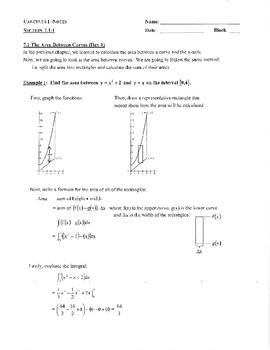
Calculus Chapter 7 Area Between Curves
This is a lesson on Area between Curves.
It includes notes on Area between Curves, Worksheet, Practice Test with the answers and a final exam review with the answers on it.
Subjects:
Grades:
10th - 12th, Higher Education, Adult Education, Staff
Types:

AP CALCULUS AB : FINDING A DERIVATIVE BY USING THE QUOTIENT RULE
The quotient rule is a process of differentiation for a quotient of two functions. This rule is for differentiating functions where one function is divided by another. The rule follows from the limit definition of derivative and is given by: f ' (x) . g(x) - f(x) . g ' (x) dy/dx =------------------------------------------ (g(x))^2In this document, the rule is given formally and several examples are worked out.The document should serve as a useful guide fo
Grades:
11th - 12th, Higher Education, Adult Education, Staff
Types:
Also included in: BASIC CALCULUS
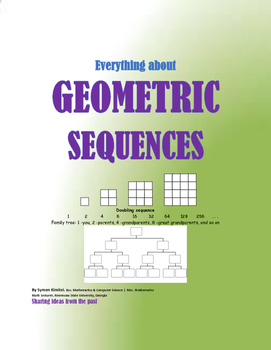
THE GEOMETRIC Series
A GEOMETRIC Series
Whenever a series of numbers follow a pattern of multiplying a term by a constant each term to arrive at the next term, we regard such a sequence as a geometric sequence. The constant multiplied each time is the same. This fixed constant that is being multiplied to arrive at the next term is called the common ratio, r, referring to the fact that the ratio (fraction) of the second term to the first term yields this constant. To find the common ratio, divide the second term b
Subjects:
Grades:
9th - 12th, Higher Education, Adult Education, Staff
Types:
Also included in: ALGEBRA I & II BUNDLED NOTES FOR ONLINE TEACHERS
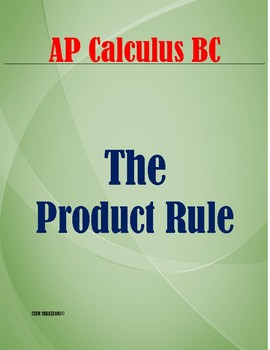
AP CALCULUS AB: FINDING A DERIVATIVE BY USING THE PRODUCT RULE
The product rule is a process of differentiation for a product of two functions. This rule is for differentiating functions where one function is multiplied by another. The rule follows from the limit definition of derivative and is given by:dy/dx = f ' (x) . g(x) + f(x) . g ' (x)In this document, the rule is given formally and several examples are worked out.The document should serve as a useful guide for introductory examples for derivatives.Knowledge about power rule and derivatives of some t
Grades:
11th - 12th, Higher Education, Staff
Types:
Also included in: BASIC CALCULUS

AP CALCULUS BC - PROOFS: PRODUCT AND QUOTIENT RULE
In this document, we provide two important calculus proofs - The product rule and quotient rule. Teachers and students alike will appreciate these two proofs. A serious mathematician is always interested in why certain theorems or rules work. Quoting them is not enough. To be able to prove them is everything. It provides conclusive evidence about why the formulas actually work generally.It is my hope that students and teachers will enjoy them.
Grades:
11th - 12th, Higher Education, Adult Education, Staff
Types:
Also included in: BASIC CALCULUS
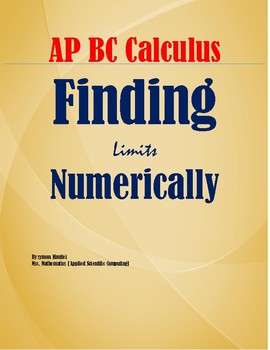
AP CALCULUS AB - FINDING LIMITS NUMERICALLY
This lesson on limits is intended for students enrolled in AP Calculus AB or BC, Calculus Honors, or College Calculus. What is a limit?A limit of a function is the idea of looking at what happens to the y values of a function as x approaches particular values of x. In this discussion of limits, we are trying to find out what the y values tend to as x approaches some x value, say x=a, from either the left side or the right hand side of the graph.In this unit, we explore what it means to find lim
Subjects:
Grades:
10th - 12th, Higher Education, Adult Education, Staff
Types:
Also included in: AP CALCULUS AB - FINDING LIMITS & FUNCTION CONTINUITY (BUNDLED LESSONS)
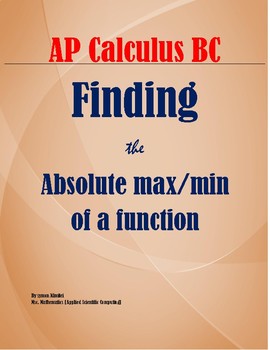
AP CALCULUS AB - ABSOLUTE MAXIMUM / MINIMUM OF A FUNCTION
This lesson on Absolute Maximum and Minimum is intended for students enrolled in AP Calculus AB or BC, Calculus Honors, or College Calculus. Using Derivatives to Find the Absolute Maximum and Minimum Values of f(x)OBJECTIVES• Find absolute extrema using Maximum-Minimum Principle I.• Find absolute extrema using Maximum-Minimum Principle II.The Extreme Value TheoremA continuous function f(x) defined over a closed interval [a, b] must have an absolute maximum value and an absolute minimum value ov
Grades:
9th - 12th, Higher Education, Adult Education, Staff
Types:
Also included in: BASIC CALCULUS
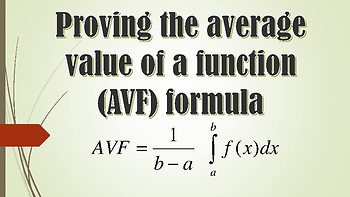
DERIVING THE AVERAGE VALUE OF A FUNCTION FORMULA
At the end of this lesson, the student should be able to:
1. Prove the average value of a function formula
2. Use the formula to find the average value of a continuous function over an interval [a,b]
Grades:
11th - 12th, Higher Education, Adult Education, Staff
Also included in: BASIC CALCULUS
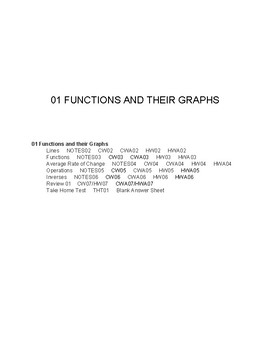
PreCalculus: Unit 1 Overview - Functions and Their Graphs
This unit covers lines, graphing of functions, average rates of change, secant lines, operations of functions and inverse functions.PLEASE NOTE: This document is a pdf not editable. You will need a pdf reader in order to view these files.If you need help with this product or have questions, please contact me.
Subjects:
Grades:
9th - 12th, Higher Education, Adult Education, Staff
Types:
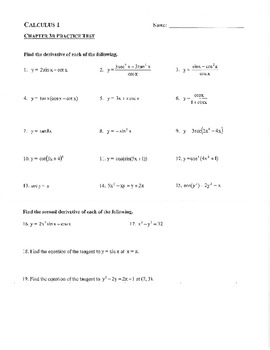
Calculus Chapter 3 Derivatives Last Part
This is the last two pages for my unit on Calculus Chapter 3 Derivatives. Includes second page for a worksheet and a practice test.
Subjects:
Grades:
10th - 12th, Higher Education, Adult Education, Staff
Types:
Showing 1-24 of 24 results


